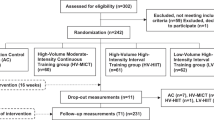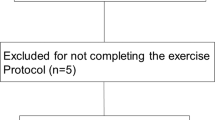Abstract
Previous studies reported that a device-guided slow-breathing (DGB) exercise decreases resting blood pressure (BP) in hypertensive patients. This study investigated the effects of daily practice of DGB on (a) 24-h BP and breathing patterns in the natural environment, as well as (b) BP and breathing pattern during clinic rest. Altogether, 40 participants with pre-hypertension or stage 1 hypertension were trained to decrease breathing rate through DGB or to passively attend to breathing (control, CTL) during daily 15-min sessions. The participants practiced their breathing exercise at home for 4 weeks. The DGB (but not the CTL) intervention decreased clinic resting BP, mid-day ambulatory systolic BP (in women only) and resting breathing rate, and increased resting tidal volume. However, 24-h BP level was not changed by DGB or CTL interventions, nor was overnight breathing pattern. These findings are consistent with the conclusion that a short-term, autonomic mechanism mediated the observed changes in resting BP, but provided no evidence that regular DGB affected factors involved in long-term BP regulation. Additional research will be needed to determine whether 24-h BP can be lowered by a more prolonged intervention.
This is a preview of subscription content, access via your institution
Access options
Subscribe to this journal
Receive 12 digital issues and online access to articles
$119.00 per year
only $9.92 per issue
Buy this article
- Purchase on Springer Link
- Instant access to full article PDF
Prices may be subject to local taxes which are calculated during checkout



Similar content being viewed by others
References
Grossman E, Grossman A, Schein MH, Zimlichman R, Gavish B . Breathing control lowers blood pressure. J Hum Hypertens 2001; 15: 263–269.
Rosenthal T, Alter A, Peleg E, Gavish B . Device-guided breathing exercises reduce blood pressure: ambulatory and home measurements. Am J Hypertens 2001; 14: 74–76.
Schein MH, Gavish B, Herz M, Rosner-Kahan D, Naveh P, Knishkowy B et al. Treating hypertension with a device that slows and regularizes breathing: a randomized, double-blind controlled study. J Human Hypertens 2001; 15 (4): 271–278.
Viskoper R, Shapira I, Priluck R, Mindlin R, Chornia L, Laszt A et al. Nonpharmacologic treatment of resistant hypertensives by device-guided slow breathing exercises. Amer J Hypert 2003; 16: 484–487.
Meles E, Giannattasio C, Failla M, Gentile G, Capra A, Mancia G . Nonpharmacologic treatment of hypertension by respiratory exercise in the home setting. Am J Hypertens 2004; 17: 370–374.
Elliott WJ, Izzo JL, White WB, Rosing DR, Snyder CS, Alter A et al. Graded blood pressure reduction in hypertensive outpatients associated with use of a device to assist with slow breathing. J Clin Hypertens 2004; 6: 553–559.
Logtenberg SJ, Kleefstra N, Houweling ST, Groenier KH, Bilo HJ . Effect of device-guided breathing exercises on blood pressure in hypertensive patients with type 2 diabetes mellitus: a randomized clinical trial. J Hypertens 2007; 25: 241–246.
Schein MH, Gavish B, Baevsky T, Kaufman M, Levine S, Nessing A et al. Treating hypertension in type II diabetic patients with device-guided breathing: a randomized controlled trial. J Hum Hypertens 2008; 23: 325–331.
Parati G, Izzo JL, Gavish B . Respiration and blood pressure. In: Izzo JL, Sica DA, Black HR (eds). Hypertension Primer. American Heart Association: Dallas, TX, 2008, pp 136–138.
Joseph CN, Porta C, Casucci G, Casiraghi N, Maffeis M, Rossi M et al. Slow breathing improves barorefex sensitivity and decreases blood pressure in essential hypertension. Hypertens 2005; 46 (4): 714–718.
Cowley AW . Long-term control of arterial blood pressure. Physiol Rev 1992; 72: 231–300.
Anderson DE, McNeely JD, Windham BG . Device-guided slow breathing effects on end tidal CO2 and heart rate variability. Psychol Health Med 2009; 14: 667–679.
Benson H, Klipper MZ . The Relaxation Response. Wings Books: New York, NY, 1992.
Wilhelm FH, Roth WT, Sackner MA . The LifeShirt. An advanced system for ambulatory measurement of respiratory and cardiac function. Behav Modif 2003; 27: 671–691.
Kario K, James GD, Marion RM, Ahmed M, Pickering TG . The influence of work- and home-related stress on the levels and diurnal variation of ambulatory blood pressure and neurohumoral factors in employed women. Hypertens Res 2002; 25: 499–506.
Guyton AC . Dominant role of the kidneys and the accessory role of whole-body autoregulation in the pathogenesis of hypertension. Amer J Hypertens 1989; 2: 575–585.
Julius S, Weder AB . Brain and the regulation of blood pressure: a hemodynamic perspective. Clin Exper Hypertens 1989; 11 (Suppl): 1–19.
Anderson DE . Behavior analysis and the search for the origins of hypertension. J Exp Anal Behav 1994; 61: 255–261.
Honig A . Peripheral arterial chemoreceptors and reflex control of sodium and water homeostasis. Am J Physiol Integ Comp Physiol 1989; 257 (26): R1282–R1302.
Anderson DE, Parsons D . Association of end tidal CO2 with longitudinal blood pressure elevation. Am J Hypertens 1999; 17: 1073–1079.
Scuteri A, Parsons DJ, Chesney MA, Anderson DE . Anger Inhibition potentiates the association of high end tidal CO2 with blood pressure of women. Psychosom Med 2001; 63: 470–475.
Anderson DE, Scuteri A, Agalakova N, Parsons DJ, Bagrov AY . Racial differences in resting end tidal CO2 and sodium pump inhibitor. Amer J Hypert 2001; 14 (8 part 1): 761–767.
Acknowledgements
This research was solely supported by the Intramural Research Program of the NIH, National Institute on Aging. The authors are indebted to Dr Deborah Grady for calling our attention to the guided breathing device, and to Drs Benjamin Gavish, S Mortesa Farasat and Margaret A Chesney for review of the paper.
Author information
Authors and Affiliations
Corresponding author
Ethics declarations
Competing interests
The authors declare no conflict of interest.
Rights and permissions
About this article
Cite this article
Anderson, D., McNeely, J. & Windham, B. Regular slow-breathing exercise effects on blood pressure and breathing patterns at rest. J Hum Hypertens 24, 807–813 (2010). https://doi.org/10.1038/jhh.2010.18
Received:
Revised:
Accepted:
Published:
Issue Date:
DOI: https://doi.org/10.1038/jhh.2010.18
Keywords
This article is cited by
-
The Effect of Slow-Paced Breathing on Cardiovascular and Emotion Functions: A Meta-Analysis and Systematic Review
Mindfulness (2024)
-
Signaling pathways in vascular function and hypertension: molecular mechanisms and therapeutic interventions
Signal Transduction and Targeted Therapy (2023)
-
Are home-based exercises effective to reduce blood pressure in hypertensive adults? A systematic review
Clinical Hypertension (2022)
-
Active Transformation of Mind and Body Through Abundant Natural Methods (ATMAN)
Wireless Personal Communications (2019)
-
Effect of respiratory pattern on automated clinical blood pressure measurement: an observational study with normotensive subjects
Clinical Hypertension (2017)



